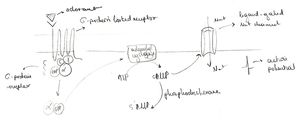Biochemistry of olfaction
From WikiLectures
Olfaction[edit | edit source]
Smell (aka olfaction), depends on sensory receptors that respond to airborne chemicals. The chemoreceptors are located in the olfactory epithelium high in the nasal cavity, beneath the cribriform plate and foramina. Three types of cells make up the olfactory epithelium;
- bipolar olfactory neurons
- supporting sustentacular cells
- basal stem cells (they provide fresh sensory neurons to replace old ones, a property that seldomly appears since neurons are not replaced elsewhere )
One kind of cells makes the body capable to discriminate many different odors since the genome contains a family of about a thousand related but distinctive to each other genes encoding different olfactory receptors. A single neuron contains all the genes encoding olfactory receptors but only a single enhancer is capable of binding to the promoters of these genes, switching them on. That is, each olfactory neuron expresses only a single type of chemoreceptors.
Signal transduction pathway of olfaction[edit | edit source]
| 1. First messenger | Ligands/odorants/chemicals |
|---|---|
| 2. Receptors | G-protein-coupled receptors |
| 3. Transducer | G-protein |
| 4. First effector | Adenylyl cyclase |
| 5. Second messengers | cAMP |
| 6. Second effector | Ligand-gated Na+ ion channels |
- The cilia of the olfactory sensory neurons are embedded in a layer of mucus in which odor molecules are dissolved.
- Binding of odorant ligands with G-protein-linked receptors induce an active ligand-receptor complex that alters its conformational orientation which in turn activates the prenylated G-protein by removal of GDP and substitution with GTP .
- The active G-protein dissociates into β,γ and α-GTP subunits with the latter allosterically activating the enzyme adenylyl cyclase.
- The adenylyl cyclase increases the formation of cAMP from ATP.
- The increased amount of cAMP opens, upon binding, ligand-gated Na+ channels allowing change in intracellular sodium concentrations altering the cellular electrical potential.
- The Na+ influx reduces the potential across the membrane in a process called depolarization.
- When this depolarization reaches a specific action potential threshold, an action potential elicits.
- The action potential propagates throughout the bipolar olfactory neuron reaching synapses where voltage-gated Ca2+channels allowing calcium ion influx.
- The increased intracellular calcium ion concentration initiates calcium mediated exocytosis of neurotransmitter vesicles through interaction of calcium ions with the microfilamentous component of cytoskeleton.
- The neurotransmitter molecules are released inside the synaptic cleft and diffuse towards the postsynaptic membrane belonging to the mitral cells of the olfactory bulb.
- Neurotrnasmitters as first messengers, bind onto and activate plasma membrane receptors (aka ligand-gated Na+channels) forming the potent ligand-receptor complex.
- This complex alters its conformational orientation and allows sodium ion influx which will subsequently induce mitral cell depolarization and eventually action potential.
- This action potential travels throughout the long mitral cell axons transported directly into the olfactory area of the cerebrum.


